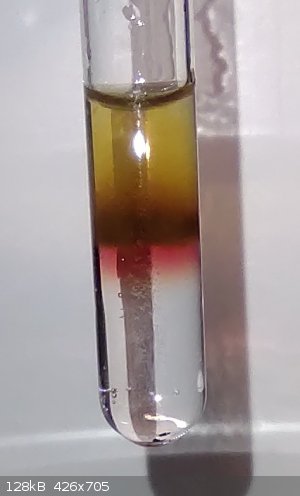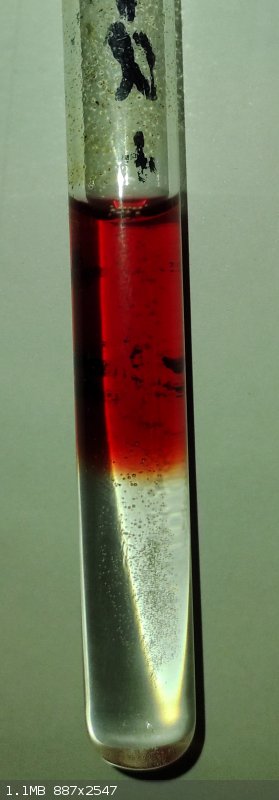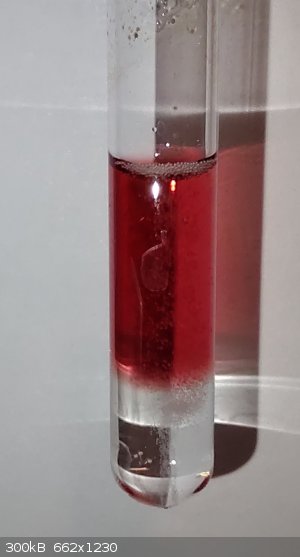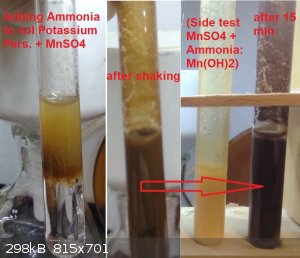RU_KLO
Hazard to Others
  
Posts: 147
Registered: 12-10-2022
Location: Argentina
Member Is Offline
|
|
Persulfate oxidation? Permanganate
Hi,
As I have a lot of Ammonium Persulfate, so decided to test it as oxiding agent.
So I took a tip of a spatula of Manganese Sulphate + a tip of a spatula of Ammonium Persulfate, added 10-20ml H2SO4 (aprox 4M), mixed and nothing
happened (no color change). Heated (alcohol lamp), some bubbles appeared, but also no color change (transparent + small bubbles).
After that, I added dropwise ammonium oxalate, which didnt mix in the solution and stayed on top, but where the 2 phases were in contact, a violet
band appeared.(between 2 clear solutions). And after gentle tapping, the upper phase got violet.
As I was messing around, did not take notes on quantities, procedure, etc.
So the next day, tried to recreate the experiment, with "proper" notes taking, but could not get the same results. (2 transparent phases with a violet
band where they meet.)
So after trying different things (changing quantities of reagents, using more dilute/concentrate acid) the "secret" layed on the time used to heat the
solution (rate or time of persulfate decomposition when heated)
For the experiment to work, it need to be short (2-3 seconds till manganese sulphate disolves completely
And the "disturbance" introduced when adding the ammonium oxalte (if added dropwise trough the wall of the test tube or squirting - if doing the last,
manganese oxalate is made in the upper layer - or I think so, because as side experiment added Ammonium oxalate to a solution of manganese sulphate, a
brown flocculent precipite is formed.
This is the procedure (for small 12 ml diameter tubes)
1) Approx 0.1 gr. MnSO4 powder + 0.1 gr (NH4)2S2O8 is placed in a test tube
2) 10ml H2SO4 (4M or more concetrated) is added (tried 1M H2SO4 and did not work)
3) the test tube is heated for 4-5 seconds in a flame (used alcohol lamp) until it starts to bubble a lot - like efervecence - (persulfate
decomposition) and the manganese sulphate is dissolved.
4) then is put in cold water to reduce the temperature to ambient temperature (to subside the effervesence) - a clear solution is obtained (sometimes
with small bubbles)
5) ammonium oxalate (no known molarity - made from ammonia and oxalic acid) solution is added by drops.
depending on the concentration of reagents, time of persulfate decomposition by heat, different results are expected. but there is a spot where a
permanganate band appears. By gently tapping the test tube, the permanganate is moved to the upper layer.
(Note: I think is permanganate because of violet color)
I want to understand
1) Why the manganese oxidation is not formed in the original solution?
2) Why is formed where the phases touch?
3) Why it does goes to the ammonium oxalate phase? (in the ammonium oxalate, sometimes manganese oxalate is formed)
As side note, today I checked the test tubes (the experiment was done 4 days ago) and all were clear, but one has the permanganate color at the bottom
(like the permanganate band descended...)
  
Go SAFE, because stupidity and bad Luck exist.
|
|
|
DraconicAcid
International Hazard
    
Posts: 4278
Registered: 1-2-2013
Location: The tiniest college campus ever....
Member Is Offline
Mood: Semi-victorious.
|
|
That colour is not permanganate, but an oxalato complex of manganese(III). Why would you add a reducing agent like oxalate if you're trying to make
permanganate?
Please remember: "Filtrate" is not a verb.
Write up your lab reports the way your instructor wants them, not the way your ex-instructor wants them.
|
|
|
RU_KLO
Hazard to Others
  
Posts: 147
Registered: 12-10-2022
Location: Argentina
Member Is Offline
|
|
thanks,
the main idea was manganese sulfate + ammonium persulfate. But no change was seen. (any different color for oxidating manganese)
The oxalate was a random testing.
[Edited on 14-11-2023 by RU_KLO]
Go SAFE, because stupidity and bad Luck exist.
|
|
|
DraconicAcid
International Hazard
    
Posts: 4278
Registered: 1-2-2013
Location: The tiniest college campus ever....
Member Is Offline
Mood: Semi-victorious.
|
|
I think to get permanganate using persulphate, you have to add silver ion as a catalyst.
Please remember: "Filtrate" is not a verb.
Write up your lab reports the way your instructor wants them, not the way your ex-instructor wants them.
|
|
|
RU_KLO
Hazard to Others
  
Posts: 147
Registered: 12-10-2022
Location: Argentina
Member Is Offline
|
|
thanks,
but idea was not to get permanganate, but to check (test) persulfate as oxidizer.
My though was as Manganese has different oxidation states, each colored different, maybe I could see different colors. (or any color change) - test
with 3% H2O2 as oxidizer readly changed MnSO4 to brown, then black.
(I know the KMnO4 + sugar experiment, which is a reduction)
Go SAFE, because stupidity and bad Luck exist.
|
|
|
Fery
National Hazard
   
Posts: 990
Registered: 27-8-2019
Location: Czechoslovakia
Member Is Offline
|
|
Add iodide and titrate the liberated I2 using Na2S2O3. Remember the reaction (NH4)2S2O8 + 2 KI is quite slow. I measured its kinetics decades ago,
maybe could dig out a paper with the experiment.
|
|
|
DraconicAcid
International Hazard
    
Posts: 4278
Registered: 1-2-2013
Location: The tiniest college campus ever....
Member Is Offline
Mood: Semi-victorious.
|
|
Quote: Originally posted by Fery  |
Add iodide and titrate the liberated I2 using Na2S2O3. Remember the reaction (NH4)2S2O8 + 2 KI is quite slow. I measured its kinetics decades ago,
maybe could dig out a paper with the experiment. |
I think almost every university or college I've been at has that reaction as an undergraduate kinetics lab. It's strongly catalyzed by small amounts
of copper.
Please remember: "Filtrate" is not a verb.
Write up your lab reports the way your instructor wants them, not the way your ex-instructor wants them.
|
|
|
woelen
Super Administrator
        
Posts: 7977
Registered: 20-8-2005
Location: Netherlands
Member Is Offline
Mood: interested
|
|
Indeed, making permanganate from persulfate and manganese(II) requires silver-ions as catalyst. Even then, the reaction is not complete. Making
permanganate in aqueous solution is not that easy. You only get small amounts. Even a small quantity of a few mg's gives a very intense deep purple
solution, not the reddish color you show in your pictures.
It's interesting to see that with the oxalate added in, you do get some oxidation (from manganese(II) to manganese(III)), while without the oxalate,
you do not get such result. Maybe it is the high pH of your solution, which leads to this result. You could also try adding only oxalic acid. Do you
get the reddish color in that case, or just bubbles of CO2 and a nearly colorless solution?
|
|
|
RU_KLO
Hazard to Others
  
Posts: 147
Registered: 12-10-2022
Location: Argentina
Member Is Offline
|
|
tryied:
1) tip of spoon (MnSo4 + ammonium persulfate) + H2SO4 (4M) + heating till MnSO4 dissolved. cooling to room temperature.
then:
a) 1M Oxalic acid -> no change - clear solution
b) oxalic acid (saturated solution) -> no change - clear solution
but then added one drop of ammonia (NH4OH) and a brown ring/band appeared (on top) . With gently tapping changed to reddish color.
From this I checked the Ammonium oxalate which was used before and was basic (ph 10) - checked with basic (ph8 - ph14) ph paper.
So probably the oxidation takes place in basic media.
(tried directly ammonia without the oxalic acid added, no change -> clear solution)

Go SAFE, because stupidity and bad Luck exist.
|
|
|
RU_KLO
Hazard to Others
  
Posts: 147
Registered: 12-10-2022
Location: Argentina
Member Is Offline
|
|
Are there other oxalato complex (better if colored)? I want to check (if I have the reagents) if this could be used for confirmation of metal present.
Or if there is a procedure/method for getting metal oxalato complex. (or is as simple to add oxalic acid or sodium/ammoniun oxalate to a salt of the
metal?
thanks
Go SAFE, because stupidity and bad Luck exist.
|
|
|
woelen
Super Administrator
        
Posts: 7977
Registered: 20-8-2005
Location: Netherlands
Member Is Offline
Mood: interested
|
|
Interesting observation.
So, alkaline oxalate solution, when added to a manganese(II)/peroxide mix, leads to formation of red/purple solution.
Only alkali added --> no redox reaction
Only oxalate added --> possibly a redox reaction, but no oxidation of manganese(II).
Then try one final thing:
Take a solution of sodium persulfate and manganese(II) sulfate. Only very small amount of added acid. This will give you a clear and colorless
solution. Then add excess ammonia or excess sodium carbonate. I expect immediate oxidation of all maganese(II) to something of higher oxidation state
(precipitate of brown manganese(III) oxide or nearly black manganese(IV) oxide, or a mix).
Manganese(II) in alkaline environment is very easily oxidized to the +3 or +4 oxidation state, but further oxidation is not easy. I expect that to
happen in your experiment at the thin layer of liquid of contact between the acidic manganese(II)/persulfate solution and the alkaline ammonia/oxalate
on top of it. The oxalate then is oxidized by manganese(IV), leading to a soluble manganese(III) species. Without oxalate, a precipitate is formed.
|
|
|
RU_KLO
Hazard to Others
  
Posts: 147
Registered: 12-10-2022
Location: Argentina
Member Is Offline
|
|
Thanks, done that. (used Potassium Persulfate instead of Sodium Persulfate)

Go SAFE, because stupidity and bad Luck exist.
|
|
|
woelen
Super Administrator
        
Posts: 7977
Registered: 20-8-2005
Location: Netherlands
Member Is Offline
Mood: interested
|
|
Here you nicely see that at high pH, Mn(2+) is easily oxidized. The brown stuff at the left you see after shaking with ammonia is mainly hydrous Mn2O3
(with MnO2 in the mix as well).
What you see at the right is oxidation by oxygen from air. This lead to formation of nearly black hydrous MnO2. So, all these experiments show that
oxidation of manganese(II) either requires extremely strong oxidizers, or high pH. At high pH, even moderate oxidizers are capable of oxidizing
manganese(II) and the oxidation in that case also is fast.
|
|
|